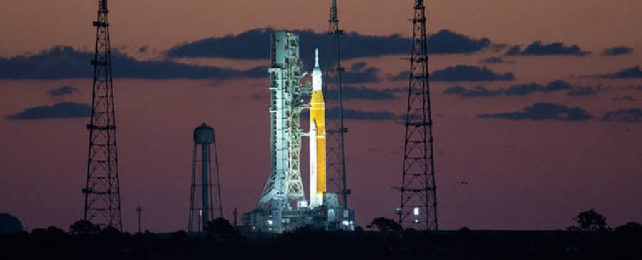On Monday morning, NASA scrubbed its first attempt to launch its historic Artemis 1 mission due to an engine bleed that's still being investigated.
In case you somehow missed the news, humans are finally planning to return to the Moon.
We're still a way off the first modern crewed mission to our planet's satellite. But Monday morning's scheduled launch attempt was going to be the first real test of the rocket that's designed to take us there.
Unfortunately, the launch was scrubbed a few minutes into the launch window at 08.36am EDT (1254 UTC) on Monday, 29 August, due to an engine bleed that didn't show the right temperature in tests.
The rocket is in a stable configuration and the team will leave it partially fueled to conduct more tests.
The earliest opportunity for the next launch window would be 12.48pm EDT (1648 UTC) on Friday, September 2 – but that's dependent on the results of ongoing tests on the engine bleed.
Roughly an hour ahead of the scheduled two-hour launch window, the countdown went into an unplanned hold at T–40 minutes.
The issue arose during fueling, when liquid hydrogen fuel began to leak out of the engine.
A similar fuel leak issue was picked up in previous tests, but it's unclear if the problem is the same this time.
The launch of #Artemis I is no longer happening today as teams work through an issue with an engine bleed. Teams will continue to gather data, and we will keep you posted on the timing of the next launch attempt. https://t.co/tQ0lp6Ruhv pic.twitter.com/u6Uiim2mom
— NASA (@NASA) August 29, 2022
Rachel Kraft explains more over at the NASA Artemis blog:
"While liquid oxygen loading into the interim cryogenic propulsion stage continues and core stage tanks continue to be replenished with propellants, engineers are troubleshooting an issue conditioning one of the RS-25 engines (engine 3) on the bottom of the core stage.
Launch controllers condition the engines by increasing pressure on the core stage tanks to bleed some of the cryogenic propellant to the engines to get them to the proper temperature range to start them.
Engine 3 is not properly being conditioned through the bleed process, and engineers are troubleshooting.
Teams also are assessing what appears to be a crack in the thermal protection system material on one of the flanges on the core stage. The flanges are connection joints that function like a seam on a shirt, are affixed at the top and bottom of the intertank so the two tanks can be attached to it."
Known as the Artemis 1 mission, this is the first in a series of increasingly complex mission designed to take humans back to the Moon for the first time since December 1972.
The new Space Launch System being used is the most powerful rocket NASA has ever launched, and it'll not only travel to the Moon – further than any spacecraft built for humans has ever flown – but also deploy some small satellites.
On board the Orion Crew Capsule there'll be a slightly strange mix of mannequins, artifacts, mementos, and zero-gravity indicators.
The goal is to practice operating the spacecraft and test the crew conditions to make sure that the spacecraft is safe for future crew.
In 2024, NASA plans to launch Artemis 2, the first crewed Artemis mission into space using an even more powerful version of the Space Launch System rocket (assuming the spacesuits are ready).
Artemis 3 is scheduled for 2025, and will aim to land the first woman and first person of color to near the Moon's south pole.
In 2027, the Artemis 4 mission will take astronauts to a mini-lunar station called Gateway.
